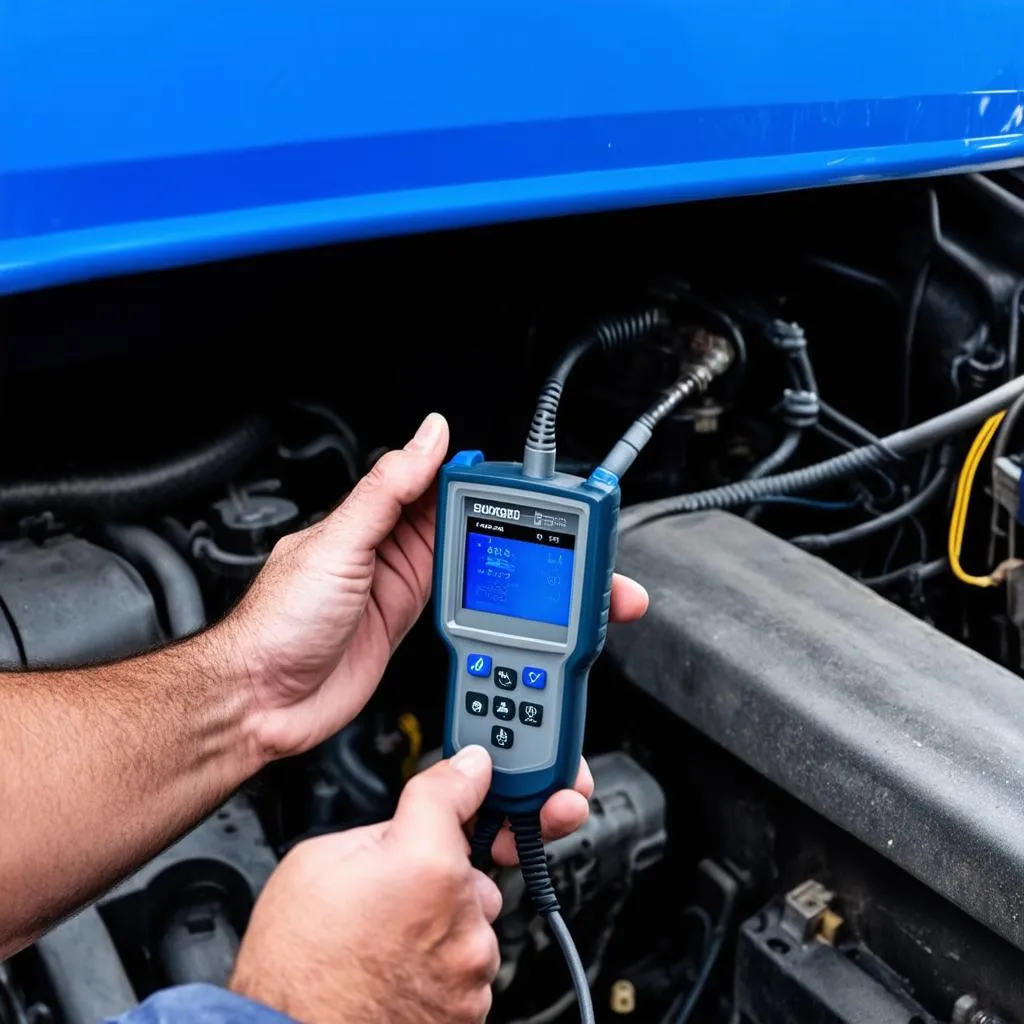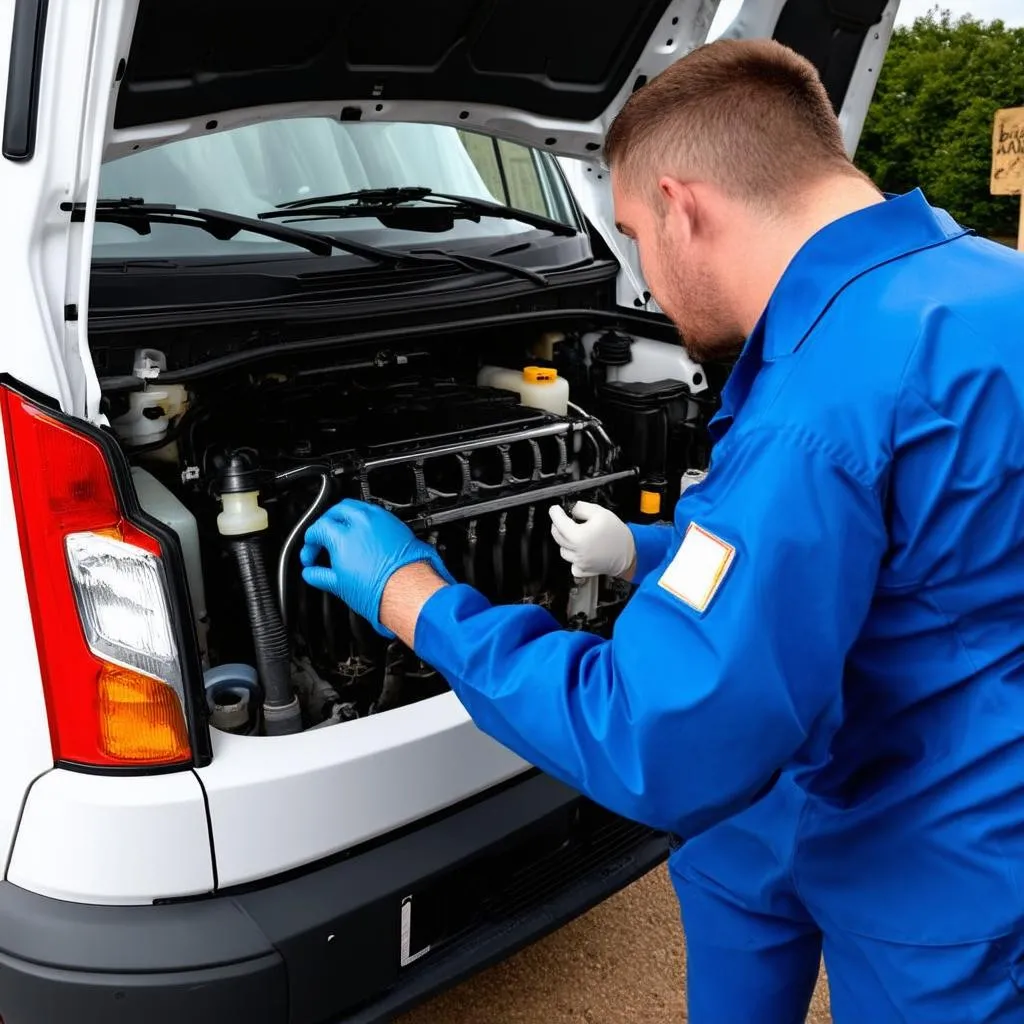Picture this: you’re cruising down the Pacific Coast Highway in your trusty Ford Transit, the California sun warming your face, when suddenly – bam! – the check engine light throws a wrench into your road trip bliss. We’ve all been there, that sinking feeling when your vehicle throws a curveball. But fear not, fellow adventurers! Understanding Ford Transit Obd Codes can empower you to tackle those automotive hiccups head-on.
What in the World are Ford Transit Obd Codes Anyway?
In the world of automotive diagnostics, OBD stands for On-Board Diagnostics. Think of it as your Transit van’s own internal communication system, constantly monitoring various systems and components for any hiccups. When something isn’t quite right, it triggers a specific code – an alphanumeric combination like “P0301” – and stores it in the vehicle’s computer.
“These codes are like clues to a detective,” explains Michael Schmidt, an automotive engineer and author of “The Modern Mechanic’s Guide.” “They provide valuable insights into the potential root cause of a problem, allowing mechanics and even DIY enthusiasts to pinpoint the issue more efficiently.”
These codes are accessed through the OBD-II port, typically located under the dashboard on the driver’s side. You can then use a code reader, also known as a scan tool or OBD scanner – readily available online or at your local auto parts store – to retrieve these codes and decipher their meaning.
Decoding the Secrets: Understanding Common Ford Transit Obd Codes
Now, let’s get down to the nitty-gritty and explore some common Ford Transit OBD codes and their potential meanings:
Engine-Related Codes
- P0301 – P0308: These codes signal a misfire in one or more cylinders. This could be due to faulty spark plugs, ignition coils, or even issues with fuel delivery or compression.
- P0171 & P0174: These codes indicate a lean fuel mixture, meaning there’s too much air or not enough fuel in the engine. Possible culprits include vacuum leaks, a malfunctioning Mass Airflow Sensor (MAF), or a faulty oxygen sensor.
- P0420 & P0400: These codes suggest a problem with the catalytic converter or the EGR (Exhaust Gas Recirculation) system, which are crucial for emissions control.
Transmission-Related Codes
- P0700: This is a general transmission control system code, often indicating a problem with the transmission control module (TCM) or its wiring.
- P0706: This code points to a faulty Transmission Range Sensor, which tells the TCM the position of your gear shifter.
Other Common Codes
- P0442 & P0455: These codes relate to the evaporative emissions control system, which prevents fuel vapors from escaping into the atmosphere.
- C1001: This code often indicates an issue with the ABS (Anti-lock Braking System) module or its communication with other systems.
This is just a small sampling of the many OBD codes your Ford Transit might display. Keep in mind that a single code can have multiple potential causes, and a thorough diagnosis often involves examining other symptoms, checking fluid levels, and conducting further tests.
Don’t Panic, Take Action: What to Do When Your Transit Talks Back
Discovering an OBD code might seem daunting, but it’s actually an opportunity to address a potential issue before it escalates into a major headache. Here’s a step-by-step guide on what to do when your Transit tries to communicate:
-
Stay Calm and Carry On (Temporarily): While some codes might warrant immediate attention, many allow you to continue driving for a short period. However, it’s always wise to consult a mechanic or refer to your owner’s manual for specific guidance based on the code.
-
Read Those Codes: As mentioned earlier, a code reader is your best friend in this situation. It will reveal the specific codes stored in your vehicle’s computer.
-
Do Your Research: Once you have the codes, hop online and search for “Ford Transit OBD Code [insert code here].” You’ll find a wealth of information, including potential causes and common fixes.
-
Seek Professional Help (When Needed): While some issues might be simple enough to tackle yourself, others require the expertise of a qualified mechanic. Don’t hesitate to seek professional help, especially if the problem involves complex systems like the transmission or engine management.
 Mechanic using an OBD scanner on a Ford Transit
Mechanic using an OBD scanner on a Ford Transit
Beyond the Codes: Proactive Maintenance for a Smooth Ride
While OBD codes are invaluable tools for diagnosis, preventing issues in the first place is always the best approach. Here are some proactive maintenance tips to keep your Transit running smoothly:
- Regular Oil Changes: Follow the recommended oil change intervals outlined in your owner’s manual. Clean oil is the lifeblood of your engine.
- Spark Plug & Filter Replacement: Spark plugs and filters (air, fuel, and cabin) have a finite lifespan. Replacing them at regular intervals ensures optimal performance and fuel efficiency.
- Fluid Checks: Regularly check your transmission fluid, coolant, brake fluid, and power steering fluid levels.
- Tire Pressure & Rotation: Maintaining proper tire pressure and rotating them regularly promotes even wear and extends their lifespan.
 A mechanic inspecting the engine bay of a Ford Transit
A mechanic inspecting the engine bay of a Ford Transit
Need Help Deciphering Those Pesky Codes? We’re Here to Help!
If you’re ever stumped by a Ford Transit OBD code or need assistance with any automotive diagnostics, don’t hesitate to reach out. Our team of automotive experts is available 24/7 to provide guidance and support. Contact us via WhatsApp at +84767531508, and let’s get your Transit back on the road in tip-top shape.
Remember, knowledge is power when it comes to your vehicle. Understanding Ford Transit OBD codes empowers you to make informed decisions and keep your van running smoothly for miles to come.
Interested in learning more about maintaining your Ford Transit? Check out our article on Ford Transit 2016 OBD-II Port for a detailed guide on locating and using the diagnostic port.